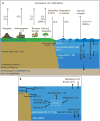Mercury biogeochemical cycling in the ocean and policy implications
- PMID: 22559948
- PMCID: PMC3427470
- DOI: 10.1016/j.envres.2012.03.013
Mercury biogeochemical cycling in the ocean and policy implications
Abstract
Anthropogenic activities have enriched mercury in the biosphere by at least a factor of three, leading to increases in total mercury (Hg) in the surface ocean. However, the impacts on ocean fish and associated trends in human exposure as a result of such changes are less clear. Here we review our understanding of global mass budgets for both inorganic and methylated Hg species in ocean seawater. We consider external inputs from atmospheric deposition and rivers as well as internal production of monomethylmercury (CH₃Hg) and dimethylmercury ((CH₃)₂Hg). Impacts of large-scale ocean circulation and vertical transport processes on Hg distribution throughout the water column and how this influences bioaccumulation into ocean food chains are also discussed. Our analysis suggests that while atmospheric deposition is the main source of inorganic Hg to open ocean systems, most of the CH₃Hg accumulating in ocean fish is derived from in situ production within the upper waters (<1000 m). An analysis of the available data suggests that concentrations in the various ocean basins are changing at different rates due to differences in atmospheric loading and that the deeper waters of the oceans are responding slowly to changes in atmospheric Hg inputs. Most biological exposures occur in the upper ocean and therefore should respond over years to decades to changes in atmospheric mercury inputs achieved by regulatory control strategies. Migratory pelagic fish such as tuna and swordfish are an important component of CH₃Hg exposure for many human populations and therefore any reduction in anthropogenic releases of Hg and associated deposition to the ocean will result in a decline in human exposure and risk.
Copyright © 2012 Elsevier Inc. All rights reserved.
Figures








References
-
- Amyot M, Morel FMM, Ariya PA. Dark oxidation of dissolved and liquid elemental mercury in aquatic environments. Environmental Science & Technology. 2005;39:110–114. - PubMed
-
- Andersson ME, Gardfeldt K, Wangberg I, Sprovieri F, Pirrone N, Lindqvist O. Seasonal and daily variation of mercury evasion at coastal and off shore sites from the Mediterranean Sea. Marine Chemistry. 2007;104:214–226.
-
- Andersson M, Gardfeldt K, Wangberg I. A description of an automatic continuous equilibrium system for the measurement of dissolved gaseous mercury. Analytical and Bioanalytical Chemistry. 2008;391:2277–2282. - PubMed
-
- Andersson M, Sommar J, Gårdfeldt K, Jutterström S. Air–sea exchange of volatile mercury in the North Atlantic Ocean. Marine Chemistry. 2011;125:1–7.
-
- Antia A, Fischer G, Blanz T, Schulz-Bull D, Scholten J, Neuer S, Kremling K, Kuss J, Peinert R, Hebbeln D, Bathmann U, Conte M, Fehner U, Zeitzschel B. Basin-wide particulate organic carbon flux in the Atlantic Ocean: Regional export patterns and potential for CO2 sequestration. Global Biogeochemical Cycles. 2001;15:845–862.
Publication types
MeSH terms
Substances
Grants and funding
LinkOut - more resources
Full Text Sources
Medical

